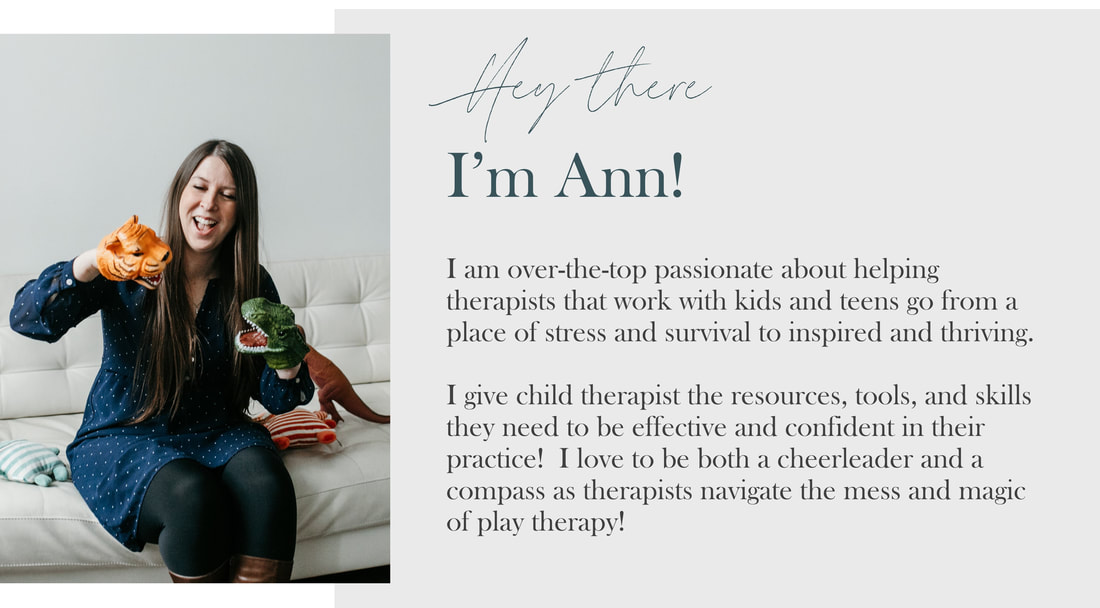|
Who loves writing Diagnostic Assessments?
*crickets* Okay - so I don’t exactly LOVE to write the assessment, but I love the unfolding of information of the unique circumstances that led to the development of client symptoms that led them to therapy.
Check out these posts HERE and HERE about how trauma impacts emotional regulation.
And at the end of all of the questions, forms, questionnaires, and assessments we end up with a diagnosis that informs our treatment plan creating the structure for our therapy sessions. As we say in the Midwest “the meat and potatoes” of it all. So it’s not a surprise that I often hear therapists and play therapists requesting different interventions for specific diagnoses. Like “can someone give me an intervention for an anxious child”? Let’s unpack this a bit. Consider how the client who has anxiety where she cannot separate from a parent at dance practice is different from the client that has a silent panic attack in class and freezes up and can’t respond. AND how are these two clients different from the anxious child that is frequently irritable and always snapping OR the anxious child that retreats into their bedroom, a book, or a video game to soothe? So, having said all this - I have a complicated relationship with diagnosis and the DSM-5 TR. For one because I take insurance I am required to complete a Diagnostic Assessment that has a DSM-5-TR diagnosis to get reimbursed. AND at the same time I understand that there are complications with the DSM-5-TR such as that it promotes a pharmaceutical approach to treatment and despite evidence presented from a number of DSM-V field trials, Developmental Trauma Disorder is not included in the DSM-5-TR. So due to the fact that every human is an individual with their own unique set of experiences and culture beyond diagnosis, in my practice I have seen great success in shifting my perspective from specific diagnosis to what is happening in a client’s nervous system. Dr. Stephen Porges developed the Polyvagal Theory as a way to explain emotional regulation through the lens of the autonomic nervous system. Specifically the role the vagus nerve plays in what part of our nervous systems are active. More on that HERE! Now let’s talk about intervention. When a client is in any state except ventral vagal (connected to self) it is because their body has deemed something in their environment a threat. As in, if I don’t react by fighting, running away, or collapsing I will die. Not on a cognitive prefrontal cortex level we know that going out on that baseball field for a game or taking a test isn’t going to end our lives. But.....our nervous system doesn’t know that. And because according to our nervous system our lives are on the line it will do whatever it takes to keep us alive. Including starting the fight/flight/collapse response to give our bodies the energy and fuel to fight (or run) for our lives. Deb Dana, who is an amazing therapist that translates the polyvagal theory into clinical practice talks about the “polyvagal ladder”. As in what goes down must come up. At the top of the ladder is ventral vagal (connected to self and regulated). All good if we are here! The next stop when we begin to climb down the ladder is sympathetic - first flight (anxious energy) and then fight (angry energy). And lastly at the bottom dorsal vagal collapse. These clients are in hypoarousal, shut down, and can have features of depression. As we begin to shift from diagnosis to nervous system state as the basis of treatment, we begin to understand that whatever dysregulation a client is bringing into session (and outside of session), fear is at the basis for the response. And in clients with trauma, the trauma memory can serve as the basis of that fear - more on thatHERE! So when we shift to a Polyvagal Theory lens we shift to interventions focused on safety and compassion for our nervous system. All behavior is an attempt at regulation - even the big, scary, and difficult behaviors. Even the behaviors that don’t make sense. And if we have this lens we can stop pushing back at the behavior and instead see it as what Ana Gomez would call storytelling - the feelings, somatic sensations, and thoughts telling the story of what has happened and what the fears are in the here and now. And when we listen to those fears we can begin to select interventions and techniques that help create a felt sense of safety for clients and can begin to teach parents, caregivers, and systems to create this safety for kids and teens as well! Lastly - we can use the Polyvagal Ladder to see how deep the threat and fear is. Animals typically run away first (typically associated with flight and anxiety) because if they can get away they don’t risk harm. If there is no possible way to run away (bigger threat) they will fight. AND it is the last effort of protection to numb out and collapse (dorsal vagal). If you are looking for more support about emotional regulation, trauma, Polyvagal Theory, and Play Therapy, check out my course Keep Calm and Regulate On: Play Therapy and the Neuroscience of Emotional Regulation! Loading...
0 Comments
Leave a Reply. |
Hi, there!I'm Ann Meehan, an LPCC, Loading... Archives
July 2024
Categories
All
|
Privacy Policies | Terms of Use | Disclaimer
Contact
[email protected] | Copyright Meehan Mental Health Services 2022
Contact
[email protected] | Copyright Meehan Mental Health Services 2022







